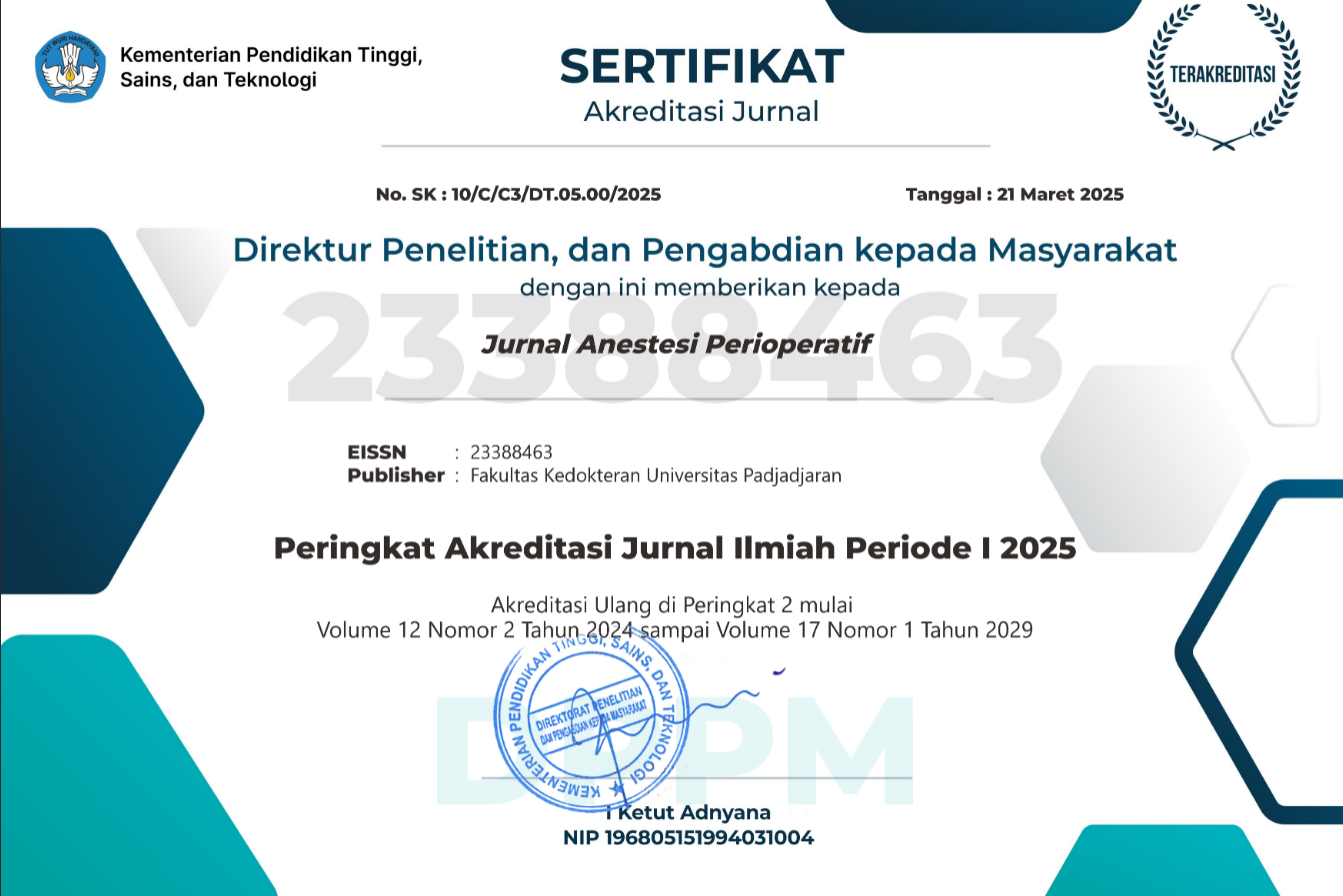Sindrom Burnout pada Peserta Program Pendidikan Dokter Spesialis Anestesiologi dan Terapi Intensif Fakultas Kedokteran Universitas Padjadjaran
Abstract
Sindrom burnout didefinisikan sebagai kelelahan kronik yang mencakup tiga komponen, yaitu kelelahan emosional, depersonalisasi, dan berkurangnya kepuasan terhadap pencapaian pribadi. Peserta Program Pendidikan Dokter Spesialis (PPDS) berisiko tinggi mengalami kelelahan dan sindrom burnout akibat beban kerja yang tinggi yang dihadapi baik dalam hal melakukan pelayanan dalam bidang anestesi dan beban dalam pendidikannya. Penelitian ini bertujuan mengetahui angka kejadian sindrom burnout pada peserta PPDS Anestesiologi dan Terapi Intensif Fakultas Kedokteran Universitas Padjadjaran (FK Unpad). Penelitian ini menggunakan metode deskriptif dan pendekatan kuesioner yang dilakukan pada peserta PPDS Anestesiologi dan Terapi Intensif FK Unpad yang masih aktif dan memberikan pelayanan di Rumah Sakit Umum Pusat (RSUP) Dr. Hasan Sadikin Bandung pada bulan April 2018 sebanyak 89 orang. Dilakukan penilaian menggunakan kuesioner yang mencakup data demografik, pendidikan dan pekerjaan, pencapaian prestasi pribadi, serta maslach burnout inventory yang sudah diterjemahkan. Hasil penelitian didapatkan angka kejadian sindrom burnout pada peserta PPDS Anestesiologi dan Terapi Intensif FK Unpad adalah 44%. Simpulan penelitian ini adalah angka kejadian sindrom burnout pada peserta PPDS Anestesiologi dan Terapi Intensif FK Unpad cukup tinggi, yaitu 44%.
Kata kunci: Depersonalisasi, kelelahan emosional, maslach burnout inventory, peserta PPDS Anestesiologi dan Terapi Intensif, sindrom burnout
Burnout Syndrome among Anesthesiology Residents in Universitas Padjadjaran
Burnout syndrome is defined as chronic exhaustion that is characterized by emotional exhaustion, depersonalization, and a sense of low professional accomplishment. The main component of this syndrome is emotional exhaustion. Residents who are being trained in anesthesiology and intensive therapy department have s high risk to exhaustion that will lead to burnout syndrome due to stressful environment and high work load in both medical service and medical education. The purpose of this study was to assess the incidence of burnout syndrome among residents in Anesthesiology and Intensive Therapy Department, Faculty of Medicine, Universitas Padjadjaran. This was a cross-sectional descriptive study on 89 residents that was performed in April 2018. Assessment was performed using a questionnaire on demographic, education, personal achievement, and medical service data as well as the translated Maslach Burnout Inventory to reveal the incidence of burnout syndrome among residents of Anesthesiology and Intensive therapy department, faculty of medicine, Universitas Padjadjaran. From the analysis, it was discovered that 44% of the residents experienced burned out syndrom. In conclusion, the incident of burn out syndrome among residents of Anesthesiology and Intensive Therapy Department, Faculty of Medicine, Universitas Padjadjaran is high.
Key words: Anesthesiology and intensive care residents, burnout syndrome, depersonalization, emotional exhaustion, Maslach burnout inventory
Keywords
Full Text:
PDFReferences
Thomas NK. Resident burnout. JAMA. 2004;292(23):2880–9.
Vinson AE. Burnout in anesthesiologist : an Update. ASA Article. 2014;78 (11):18–20.
Hyman SA, Michaels DR, Berry JM, Schildcrout JS, Mercaldo ND, Weinger MB. Risk of burnout in perioperative clinicians: a survey study and literature review. Anesthesiology. 2011;114(1):194–204.
Veintemilla F. Fatigue and Its Correlation With Diseases, Suicide and Medical Malpractice. Dalam: Occupational Well-being in Anesthesiologists. Volume.1. Penyunting Neto GFD. Rio de Janeiro; 2014. Hlm.37–50.
Heinemann. LV, Heinemann T. Burnout Research: emergence and scientific investigation of a contested diagnosis. SAGE Open. 2017;7(1):1–12.
Khetarpal R, Veena C, Jangjit K, Ashish V. Occupational stress in anesthesiologists and coping strategies: A Review. IJSS. 2015;3(6):188–92.
Maslach C, Jackson S, Leiter M. The Maslach Burnout Inventory Manual. Dalam: Evaluating Stress : A Book of Resources. Edisi ke-3. 1997. Hlm.191–218.
Gupta N GA, Garg R. Professional Burnout in anaesthesia and critical care - How to decrease it. J Anaesth Crit Care. 2015;2(3):00056.
McKinley TF, Boland KA, Mahan JD. Burnout and interventions in pediatric residency: A literature review. Burnout Research. 2017;6:9–17.
Magalhaes E, Oliveira ÁCMdS, Goveia CS, Ladeira LCA, Queiroz DM, Vieira CV. Prevalence of burnout syndrome among anesthesiologists in the federal district. Rev Bras Anestesiol. 2015;65:104–10.
Turgut N, Karacalar S, Polat C, Kiran O, Gultop F, Kalyon ST, dkk. Burnout syndrome during residency. Turk J Anaesthesiol Reanim. 2016; 44(5): 258–64.
IsHak WW, Lederer S, Mandili C, Nikravesh R, Seligman L, Vasa M, dkk. Burnout during residency training: A literature review. JGME. 2009;1(2):236–42.
Chaput B, Bertheuil N, Jacques J, Smilevitch D, Bekara F, Soler P, dkk. Professional burnout among plastic surgery residents. Ann Plast Surg. 2015;75(1):2–8.
Shidhaye RV, Divekar DS, Dhulkhed VK, Goel G, Gupta A, Shidhaye R. Evaluation of stressors and coping strategies for Stress in Indian anaesthesiologists. Indian J Anaesth. 2011;55(2):193–98.
Carlotto M PA, Bones K, Oliveira-Machado R. Prevalence and factors associated with burnout syndrome in professionals in basic health units. Cienc Trab. 2013;15(47):76–80
K. Pereira-Lima, S.R.Loureiro. Burnout, anxiety, depression, and social skills in medical residents. Dalam : Psychology, Health and Medicine. Volume.20. Penyunting Taylor, Francis. 2015. Hlm.353–62.
DOI: https://doi.org/10.15851/jap.v6n3.1360
Article Metrics
Abstract view : 2922 timesPDF - 1388 times
This Journal indexed by

JAP is licensed under a Creative Commons Attribution-NonCommercial 4.0 International License
View My Stats



